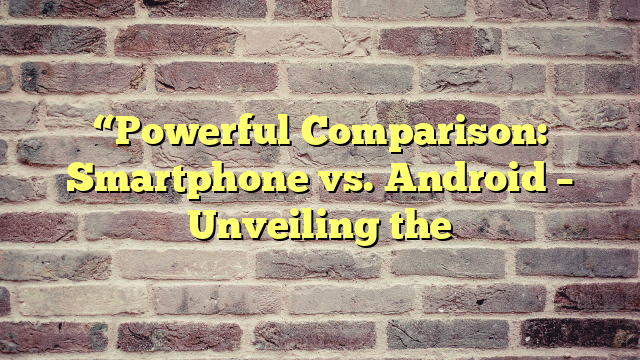Introduction:
In today’s fast-paced world, smartphones have become an essential part of our daily lives. From communication to entertainment, smartphones have revolutionized the way we live and work. With the increase in demand for smartphones, there has been a surge in the availability of different operating systems in the market, with Android being the most popular one. In this article, we will compare and contrast the features, performance, and user experience of smartphones and Android devices, and determine which one stands out as the better option.
Subheading 1: Understanding the Basics of Smartphones and Android
Before we delve into the comparison, let us first understand the basics of smartphones and Android. A smartphone is a handheld device that combines the functionality of a computer with a mobile phone. It allows users to make calls, send messages, access the internet, and run various applications. On the other hand, Android is a mobile operating system developed by Google, which is used by many smartphone manufacturers such as Samsung, Huawei, and LG. It is an open-source platform, meaning it can be modified and customized by various manufacturers according to their preferences.
Subheading 2: Design and Build Quality
When it comes to design and build quality, smartphones and Android devices have their own unique features. Smartphones generally have a sleek and modern design with a large touchscreen display. On the other hand, Android devices come in various shapes and sizes, with some having physical keyboards and others having a full touchscreen display. In terms of build quality, both smartphones and Android devices are made with high-quality materials, such as glass and metal, giving them a premium feel.
Subheading 3: Operating System and User Interface
One of the main differences between smartphones and Android devices is the operating system and user interface. Smartphones usually run on either iOS or Windows, while Android devices run on the Android operating system. The user interface of smartphones is intuitive and user-friendly, with a simple layout and easy navigation. Android devices, on the other hand, offer a more customizable user interface, allowing users to personalize their device with widgets and various themes.
Subheading 4: Performance and Battery Life
When it comes to performance, both smartphones and Android devices offer high-speed processors and ample storage space, making them suitable for multitasking and running heavy applications. However, Android devices have an edge over smartphones when it comes to battery life. Due to its open-source platform, Android devices offer a longer battery life compared to smartphones, as manufacturers can optimize the operating system to suit their device’s specifications.
Subheading 5: Camera and Photography
Smartphones and Android devices are equipped with high-quality cameras, making them perfect for capturing memories and taking stunning photographs. However, the cameras on Android devices offer more features and customization options, making them a favorite among photography enthusiasts. The camera software on Android devices also allows for manual control of settings such as ISO, shutter speed, and exposure, giving users more control over their photos.
Subheading 6: App Availability and Security
Another important aspect to consider when comparing smartphones and Android devices is the availability of apps and security. Smartphones have a wider range of apps available, especially for iOS users, as the Apple App Store has strict guidelines for app developers. However, Android devices have the advantage of having access to the Google Play Store, which offers a vast selection of apps and games. In terms of security, smartphones have a closed ecosystem, making them less vulnerable to malware and viruses compared to Android devices.
Subheading 7: Cost and Value for Money
Last but not least, the cost and value for money is an essential factor when deciding between a smartphone and an Android device. Smartphones, particularly Apple’s iPhone, tend to be on the higher end of the price spectrum, making them less affordable for some users. On the other hand, Android devices come in a wide range of prices, making them more accessible to a larger market. Additionally, Android devices offer more value for money, as they offer a range of features and customization options at a lower cost.
Conclusion:
In conclusion, both smartphones and Android devices have their own unique features and advantages. While smartphones offer a sleek design and user-friendly interface, Android devices offer more customization options and better battery life. When it comes to cost, Android devices offer better value for money, making them a popular choice among users. Ultimately, the decision between a smartphone and an Android device boils down to personal preferences and requirements. We hope this article has provided you with valuable insights to help you make an informed decision.

